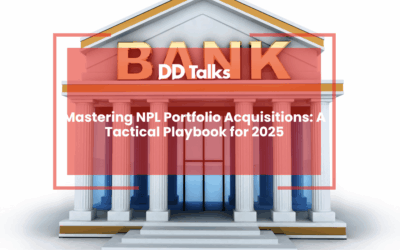Key Takeaways
- NPL management has evolved from manual processes to proactive, AI-driven strategies following the European financial crises
- AI enables banks to analyze diverse datasets simultaneously, identifying subtle default patterns and continuously improving through machine learning
- Effective NPL analytics requires integration of core financial data with behavioral metrics, external economic indicators, and regulatory information
- Machine learning models like random forests, neural networks, and NLP algorithms have revolutionized NPL assessment accuracy and efficiency
- Predictive modeling with early warning systems can identify at-risk loans before they become non-performing, enabling preventative intervention
- Process automation through AI has transformed document processing, communication workflows, and decision-making in NPL management
- European banks implementing AI-powered NPL strategies have achieved significant improvements in recovery rates, cost reduction, and NPL ratio reduction
- Future NPL optimization will focus on explainable AI, advanced portfolio valuation, collaborative ecosystems, and regulatory technology integration
Table of Contents
- The Evolution of NPL Management in Modern Banking
- How AI Transforms Non-Performing Loan Analytics
- Essential Data Sources for Effective NPL Analytics
- Machine Learning Models That Revolutionize NPL Assessment
- Implementing Predictive Modeling for NPL Risk Reduction
- Automating NPL Processes: From Manual to AI-Driven
- Real-World Success Stories: AI-Powered NPL Strategies
- Future Trends in NPL Portfolio Optimization
The Evolution of NPL Management in Modern Banking
Non-performing loan (NPL) management has undergone a remarkable transformation in European banking over the past decade. Traditionally, NPL management relied heavily on manual processes, with credit officers reviewing individual cases based on limited data points and standardised procedures. This approach was not only time-consuming but also prone to inconsistencies and human error.
Following the 2008 financial crisis and subsequent European debt crisis, NPL ratios skyrocketed across the continent, with countries like Greece, Italy, and Portugal experiencing particularly severe impacts. This surge prompted regulatory bodies, including the European Central Bank and European Banking Authority, to implement stricter guidelines for NPL classification and management. Banks were suddenly faced with the dual challenge of managing growing NPL portfolios while adapting to intensified regulatory scrutiny.
The traditional reactive approach to NPL management has gradually given way to more proactive strategies. Modern NPL management now emphasises early identification of potential defaults, sophisticated risk assessment methodologies, and tailored resolution strategies. This evolution has been accelerated by technological advancements, particularly in data analytics and artificial intelligence, which have fundamentally changed how financial institutions approach distressed assets.
How AI Transforms Non-Performing Loan Analytics
Artificial intelligence has revolutionised non-performing loan analytics by introducing unprecedented capabilities for data processing and pattern recognition. Unlike traditional statistical methods, AI can analyse vast and diverse datasets simultaneously, identifying subtle correlations and risk factors that would otherwise remain hidden. This enhanced analytical power enables banks to develop more nuanced understandings of default patterns and borrower behaviours.
One of the most significant advantages of AI in NPL analytics is its ability to continuously learn and adapt. Machine learning algorithms improve over time as they process more data, allowing NPL management systems to become increasingly accurate in their predictions and recommendations. This adaptive capability is particularly valuable in the dynamic economic environment of European markets, where default drivers can shift rapidly due to macroeconomic changes, regulatory adjustments, or sector-specific disruptions.
AI-powered NPL analytics also excel at incorporating unstructured data into assessment models. Traditional approaches typically relied solely on structured financial information, but AI can extract valuable insights from diverse sources such as customer communications, social media activity, news reports, and market sentiment indicators. By leveraging technology in distressed loans, banks can develop more comprehensive risk profiles and identify early warning signals that might not be apparent in conventional financial metrics.
Essential Data Sources for Effective NPL Analytics
Successful NPL analytics depends heavily on the quality, diversity, and integration of data sources. Core financial data remains fundamental, including loan performance histories, repayment patterns, and financial statements. These traditional metrics provide the foundation for NPL assessment but must be supplemented with additional data types to create truly robust analytics capabilities.
Behavioural data has emerged as a critical component of modern NPL analytics. This includes transaction patterns, communication preferences, response rates to previous collection efforts, and digital banking interactions. By analysing behavioural indicators, banks can identify subtle changes that might signal financial distress before it manifests in missed payments, enabling earlier and more effective intervention strategies.
External data sources significantly enhance NPL analytics by providing contextual information. These include macroeconomic indicators (GDP growth, unemployment rates, inflation), industry-specific metrics, property valuations for secured loans, and regional economic health indicators. European banks increasingly incorporate alternative data sources such as utility payment records, telecom data, and even social media sentiment analysis to enrich their NPL assessment models.
Regulatory and compliance data must also be integrated into NPL analytics frameworks. This includes information related to anti-money laundering (AML) requirements, know-your-customer (KYC) documentation, and jurisdiction-specific legal constraints on collection and resolution activities. Effective NPL management requires seamless integration of these diverse data streams into unified analytics platforms that can process and derive actionable insights from heterogeneous information sources.
Machine Learning Models That Revolutionize NPL Assessment
Several machine learning models have proven particularly effective for NPL assessment in European banking contexts. Supervised learning algorithms, including random forests and gradient boosting machines, excel at predicting default probabilities by identifying complex relationships between borrower characteristics and loan performance outcomes. These models can be trained on historical data to recognise patterns associated with different default scenarios, enabling more accurate risk scoring and segmentation.
Deep learning neural networks represent another powerful approach for NPL assessment. These sophisticated models can process vast amounts of structured and unstructured data simultaneously, identifying subtle patterns that might escape detection by simpler algorithms. Neural networks are particularly valuable for analysing complex borrower profiles with numerous variables and non-linear relationships between risk factors.
Clustering and unsupervised learning techniques help banks identify natural groupings within their NPL portfolios. By segmenting distressed loans based on similar characteristics, financial institutions can develop more targeted resolution strategies for each cluster. This approach enables more efficient resource allocation and higher recovery rates by matching intervention approaches to the specific needs and circumstances of different borrower segments.
Natural language processing (NLP) models have become increasingly important for extracting insights from text-based data sources. These algorithms can analyse customer communications, call centre notes, and legal documentation to identify sentiment, intention, and other qualitative factors that influence repayment behaviour. European banks are increasingly deploying NLP capabilities to enhance their understanding of borrower circumstances and tailor their engagement strategies accordingly.
Implementing Predictive Modeling for NPL Risk Reduction
Predictive modeling for NPL risk reduction begins with early warning systems that identify loans at risk of default before they become non-performing. These systems typically combine traditional credit risk metrics with alternative data sources and machine learning algorithms to calculate dynamic risk scores. By continuously monitoring these scores, banks can implement targeted intervention strategies for high-risk accounts, potentially preventing defaults through proactive engagement.
Effective implementation requires careful model selection and customisation. Different loan types and customer segments may require distinct predictive approaches. For instance, corporate NPLs might benefit from models that emphasise industry trends and cash flow projections, while retail NPLs might be better assessed through behavioural scoring and affordability metrics. European banks must develop model ecosystems that address the specific characteristics of their loan portfolios while maintaining regulatory compliance.
Validation and continuous improvement processes are essential components of predictive modeling for NPLs. Models must be regularly tested against actual outcomes to ensure they maintain their predictive power over time. This is particularly important in the European context, where economic conditions can vary significantly across member states and regulatory requirements continue to evolve. Leading institutions implement robust model governance frameworks that include regular backtesting, performance monitoring, and recalibration procedures.
Integration with operational systems represents the final critical element of successful predictive modeling implementation. Even the most sophisticated models provide limited value if their outputs aren’t seamlessly incorporated into day-to-day NPL management workflows. European banks are increasingly investing in technology platforms that enable real-time risk assessment and automated decision support, ensuring that predictive insights translate directly into effective action.
Automating NPL Processes: From Manual to AI-Driven
Process automation represents one of the most transformative applications of AI in NPL management. Traditional NPL workflows often involve numerous manual steps, from document review and borrower communication to decision-making and reporting. By automating these processes, European banks can significantly improve efficiency, reduce operational costs, and ensure consistent application of policies and procedures.
Document processing automation has emerged as a particularly valuable capability. Advanced optical character recognition (OCR) and natural language processing technologies can extract relevant information from loan documentation, legal filings, and correspondence. This automation eliminates time-consuming manual review processes while reducing errors and ensuring that all pertinent information is captured and incorporated into NPL management systems.
Communication workflows represent another area where automation delivers substantial benefits. AI-powered systems can generate personalised communications based on borrower profiles, payment histories, and previous interactions. These systems can also optimise contact timing and channel selection to maximise response rates. Some European banks have implemented sophisticated conversation bots that can handle routine inquiries and payment arrangements, freeing human agents to focus on more complex cases requiring specialised expertise.
Decision automation represents the most advanced form of NPL process automation. By combining predictive models with business rules engines, banks can create systems that automatically recommend or implement appropriate actions for different NPL scenarios. These might include offering specific restructuring options, initiating legal proceedings, or referring accounts to specialised collection units. While human oversight remains essential, particularly for complex cases and high-value exposures, automation can significantly accelerate decision-making while ensuring consistency and compliance.
Real-World Success Stories: AI-Powered NPL Strategies
Several European financial institutions have achieved remarkable results through AI-powered NPL strategies. A major Spanish bank implemented an advanced early warning system that combined traditional financial metrics with alternative data sources and machine learning algorithms. This system improved default prediction accuracy by over 30% compared to traditional scoring methods, allowing the bank to intervene earlier and more effectively with at-risk borrowers. Within 18 months of implementation, the bank reduced its NPL ratio by 2.3 percentage points while simultaneously decreasing its provisioning costs.
An Italian banking group deployed an AI-driven segmentation and treatment optimisation platform for its substantial NPL portfolio. The system analysed thousands of variables to identify optimal resolution strategies for different borrower segments, ranging from restructuring options to legal proceedings. By matching intervention approaches to specific borrower characteristics, the bank increased its recovery rates by 18% while reducing the average time to resolution by nearly five months.
A consortium of Nordic banks collaborated on a shared AI platform for SME loan risk assessment and NPL management. The system incorporated industry-specific performance metrics, regional economic indicators, and proprietary banking data to create highly accurate default prediction models. Participating institutions reported a collective 25% reduction in new NPL formation among small business borrowers, demonstrating the power of collaborative approaches to AI-powered risk management.
A Central European financial institution implemented an end-to-end automation solution for its retail NPL portfolio. The system handled everything from early-stage delinquency management to advanced collection strategies, with minimal human intervention required for routine cases. This automation reduced operational costs by 42% while improving collection effectiveness, allowing the bank to manage a larger NPL volume without increasing staffing levels.
Future Trends in NPL Portfolio Optimization
The future of NPL portfolio optimization will be shaped by several emerging technologies and methodologies. Explainable AI (XAI) is gaining prominence as regulatory bodies increasingly demand transparency in algorithmic decision-making. Future NPL management systems will need to balance predictive power with interpretability, providing clear explanations for their recommendations and actions. This trend is particularly relevant in the European context, where the General Data Protection Regulation (GDPR) establishes strict requirements regarding automated decision-making.
Advanced portfolio valuation techniques will continue to evolve, incorporating more sophisticated approaches to scenario analysis and stress testing. Machine learning models capable of simulating multiple economic scenarios and their impacts on NPL portfolios will enable more accurate provisioning and capital allocation. These capabilities will be particularly valuable as European banks navigate uncertain economic conditions and prepare for potential future crises.
Collaborative ecosystems for NPL management represent another significant trend. Rather than developing all capabilities in-house, financial institutions are increasingly partnering with specialised fintech providers, data analytics firms, and even competitors to create shared platforms for NPL assessment and resolution. These collaborative approaches enable smaller institutions to access sophisticated technologies while allowing larger banks to benefit from diverse data sources and specialised expertise.
Regulatory technology (RegTech) integration will become increasingly important for NPL management as compliance requirements continue to evolve. Future NPL optimization systems will incorporate real-time regulatory monitoring and automated compliance checks, ensuring that resolution strategies remain within legal and regulatory boundaries. This integration will be particularly valuable for banks operating across multiple European jurisdictions with varying legal frameworks for debt collection and resolution.
Ultimately, the future of NPL portfolio optimization lies in holistic approaches that combine technological innovation with human expertise. While AI and analytics will continue to enhance efficiency and effectiveness, successful NPL management will always require a deep understanding of borrower circumstances, market conditions, and regulatory environments. The most successful European banks will be those that leverage technology to augment rather than replace human judgment, creating synergistic relationships between digital capabilities and specialist knowledge.
Frequently Asked Questions
What are non-performing loans (NPLs) and why are they important for banks?
Non-performing loans (NPLs) are loans where borrowers have failed to make scheduled payments for a specified period (typically 90+ days). They’re critically important for banks because high NPL ratios negatively impact profitability, capital adequacy, lending capacity, and regulatory compliance. Effective NPL management is essential for maintaining financial stability and supporting economic growth.
How is AI changing the way banks manage non-performing loans?
AI is transforming NPL management by enabling advanced pattern recognition across vast datasets, continuous learning from outcomes, incorporation of unstructured data, early warning detection, automated workflows, and personalized resolution strategies. These capabilities allow banks to identify potential defaults earlier, develop more accurate risk assessments, and implement more effective intervention strategies than traditional manual approaches.
What data sources are most valuable for NPL analytics?
The most valuable data sources for NPL analytics include core financial data (payment histories, financial statements), behavioral data (transaction patterns, communication preferences), external contextual data (macroeconomic indicators, industry metrics, property valuations), alternative data (utility payments, telecom data, social media), and regulatory/compliance information. Effective NPL management requires seamless integration of these diverse data streams.
Which machine learning models work best for NPL assessment?
The most effective machine learning models for NPL assessment include supervised learning algorithms (random forests, gradient boosting machines), deep learning neural networks, clustering/unsupervised learning techniques, and natural language processing models. Different loan types and portfolios may require distinct modeling approaches, with many banks implementing multiple complementary models for comprehensive NPL assessment.
How can banks implement predictive modeling to reduce NPL risk?
Banks can implement predictive modeling for NPL risk reduction by developing early warning systems, selecting and customizing appropriate models for different portfolio segments, establishing robust validation and continuous improvement processes, and integrating predictive insights with operational systems. Successful implementation requires both technical expertise and effective change management to ensure models deliver practical value.
What NPL processes can be effectively automated with AI?
AI can effectively automate numerous NPL processes including document processing (using OCR and NLP), communication workflows (personalized messaging and channel optimization), borrower segmentation, treatment strategy selection, routine decision-making, performance monitoring, and regulatory reporting. While complex cases still benefit from human expertise, automation can handle a significant portion of NPL management activities with greater efficiency and consistency.
What future trends will shape NPL portfolio optimization?
Key future trends in NPL portfolio optimization include explainable AI (providing transparency in algorithmic decisions), advanced portfolio valuation techniques (incorporating sophisticated scenario analysis), collaborative ecosystems (partnerships between banks and specialized providers), regulatory technology integration (automated compliance monitoring), and holistic approaches that effectively combine technological capabilities with human expertise.




0 Comments